Introduction
The bean plataspid, Megacopta cribraria (Fabricius), also known as the kudzu bug, lablab bug, and globular stink bug, is native to Asia. The bean plataspid was first reported in the United States in October 2009 (Eger et al. 2010). Before its detection, species of the family Plataspidae were not known to be in the Western Hemisphere. Aggregations were first detected on the outside of houses and surrounding vegetation in Georgia. Currently, the distribution of the bean plataspid in the US includes six southeastern states.
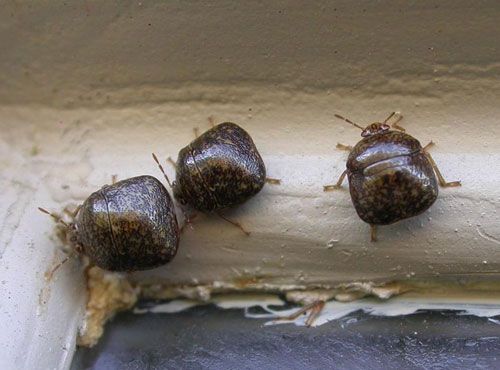
Credit: Daniel R. Suiter, University of Georgia, http://www.bugwood.org
DNA data confirmed that the introduction of the bean plataspid to the United States occurred from a single female lineage originating in Japan (Jenkins and Eaton 2011). DNA from two endosymbionts (organisms that live within another organism) found in bean plataspids in the United States confirmed that the same endosymbionts are found in Megacopta sp. in Japan. The two endysombionts are Candidatus Ishikawaella capsulata (gamma-proteobacterium in Enterobacteriales) and Wolbachia (alpha-proteobacterium in Rickettsiales) (Jenkins and Eaton 2011).
In Japan, there are two similar Megacopta species: Megacopta punctatissima and Megacopta cribraria. Older literature suggested that Megacopta punctatissima was a variety of Megacopta cribraria, but they are now recognized as two species (Eger et al. 2010). Megacopta punctatissima is a pest of soybean in mainland Japan. However, Megacopta cribraria is found on Japanese islands and is not known to be an agricultural pest there. These two species have the same morphological characteristics but do not possess the same gut symbiotic bacteria. The symbiotic bacteria of Megacopta punctatissima allows for digestion of legumes whereas the symbiotic bacteria of Megacopta cribraria does not. In the United States, bean plataspid populations possess gut symbiotic bacteria capable of breaking down legumes and are a pest of soybean and other legumes. Despite differences in behavior and symbiotic bacteria, the identification of Megacopta cribraria in the United States is confirmed by molecular characteristics previously reported in native regions.
Synonymy
Cimex cribraria Fabricius 1798
Tetyra cribraria Fabricius 1803
Thyreocoris cribrarius [sic] Burmeister 1835
Coptosoma cribrarius Fabricius 1843
Coptosoma xanthochlora Walker 1867
Megacopta cribraria Hsiao and Ren 1977
Distribution
Before the introduction of the bean plataspid to the United States, species of the family Plataspidae were confined to the Old World (Europe, Africa, and Asia). The native distribution of the bean plataspid includes Australia, China, India, Indonesia, Japan, Korea, Malaysia, Myanmar, New Caledonia, Pakistan, Sri Lanka, Taiwan, Thailand, and Vietnam (Eger et al. 2010).
During October 2009, specimens and photos of the bean plataspid from infested homes were submitted from various locations across northeast Georgia. The specimens and photos were identified by morphological characteristics and molecular, DNA-based diagnosis. After the initial discovery, the bean plataspid was reported from nine counties in northeast Georgia (Suiter et al. 2010b). By the following year, the bean plataspid was reported from 80 counties in Georgia and 16 counties from South Carolina (Jenkins and Eaton 2011). Currently, the bean plataspid is reported in the following states: Alabama, northern Florida, Georgia, South Carolina, North Carolina, and southern Virginia.
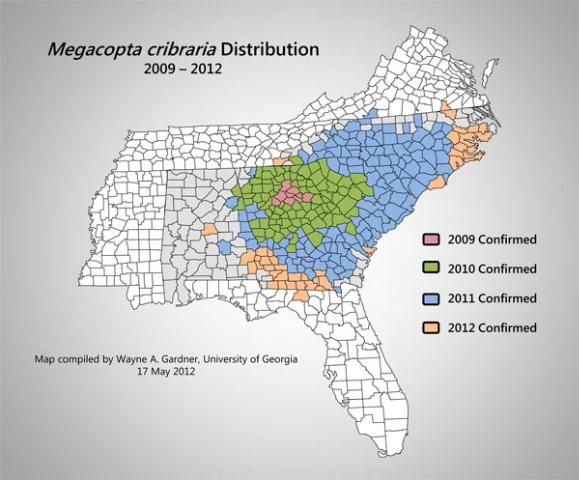
Credit: Wayne A. Gardner, University of Georgia
Description
Adults
The adults are small (3.5–6 mm) with a rounded oblong shape and live 23 to 77 days. The dorsal side of the insect is covered in numerous dark punctations and is typically light brown to olive green in color. The scutellum (posterior plate along the dorsal side of the thorax) is enlarged and covers the forewings and most of the abdomen—this is characteristic of plataspids, as well as scutellerids (shield-back bugs) and thyreocorids. More common stink bugs tend to have a triangular shaped scutellum. The scutellum is also truncated with a flattened posterior end, a characteristic unique to this species when compared to other stink bugs in North America. The most distinguishing characteristics of the bean plataspid include its size, two-segmented tarsi, and enlarged, truncated scutellum (Eger et al. 2010).
Eggs
Each egg mass has 26 to 274 eggs. The eggs tend to be a pale salmon color with dark bands intermediately spaced in a horizontal direction. The eggs are elongate and have a truncated ring of rugged projections at one end. Along with the eggs, females also deposit dark capsules underneath the eggs. These dark capsules are filled with endosymbionts (bacteria) that immature insects consume for nutritional development.
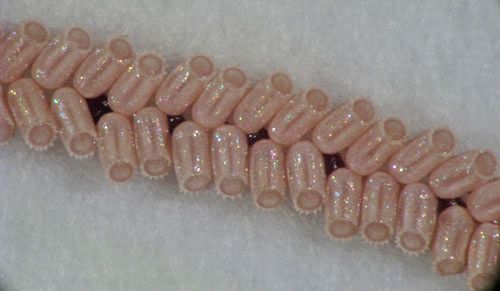
Credit: Paul Smith, University of Georgia, www.bugwood.org.
Nymphs
This species has five nymphal instars. Each nymphal instar takes two to 56 days to develop. Nymphs have a hairy appearance and vary in color but tend to be pale orange, olive green, or light brown.
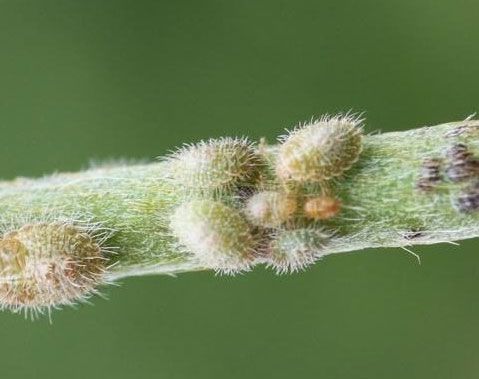
Credit: John Ruberson, University of Georgia, http://www.bugwood.org
Life Cycle
In its native habitat, there are up to three generations of the bean plataspid per year (Eger et al. 2010, Halbert and Eger 2010). The insect colonizes from April to July, forming large mating aggregations, and continues to be present until October. However, the bean plataspid may be active all year in warmer climates (Eger et al. 2010). As they go through reproductive diapause, adults overwinter on nearby buildings and structures, leaf litter, or under the bark of trees.
Hosts
The primary hosts of Megacopta cribraria in its native regions are legumes (Fabaceae): mainly soybean, Glycine max Merrill; kudzu, Pueraria montana var. lobata (Willd.) Ohwi; and lablab bean, Lablab purpureus (Linnaeus) Sweet. Megacopta cribraria is reported to develop only on soybean and kudzu in the United States. The adults and nymphs feed on the leaves, stem, flower, and pod of the host plant (Eger et al. 2010, Jenkins and Eaton 2011).
Table 1 is a list of observed hosts of Megacopta spp. from past literature. Although additional plants other than legumes are listed, it is not confirmed if these plants are used as developmental hosts or if individual adults were observed simply perched on these plants.
Economic Importance
In its native regions, M. cribraria is not an agricultural pest. However in the United States, the bean plataspid is reported to be a pest of soybean in Georgia and South Carolina. The nymphs and adults congregate in high numbers and feed on the underside of leaves and the stem of the plant. Feeding damage results in abnormal pod development and necrotic areas on the plant.
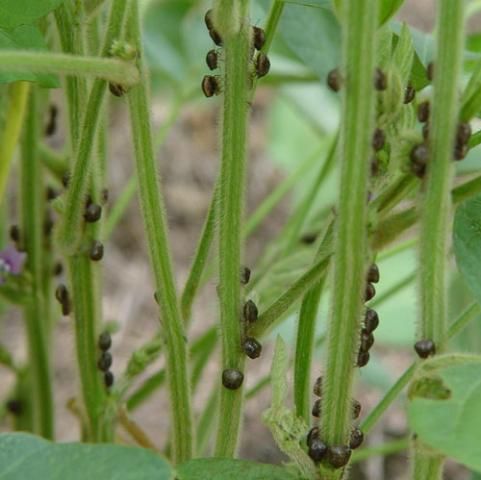
Credit: Philip Roberts, University of Georgia, http://www.bugwood.org
Adults from established bean plataspid populations within the United States are reported to overwinter on light colored structures, in leaf litter and underneath the bark of trees. These insects are attracted to light colored surfaces, predominately white and yellow (Horn and Hanula 2011). Also, like stink bugs, adults tend to excrete an odor as a defense mechanism when disturbed. The defense chemical these insects secrete may stain the surface of the house, building, or vehicle where aggregation occurs.
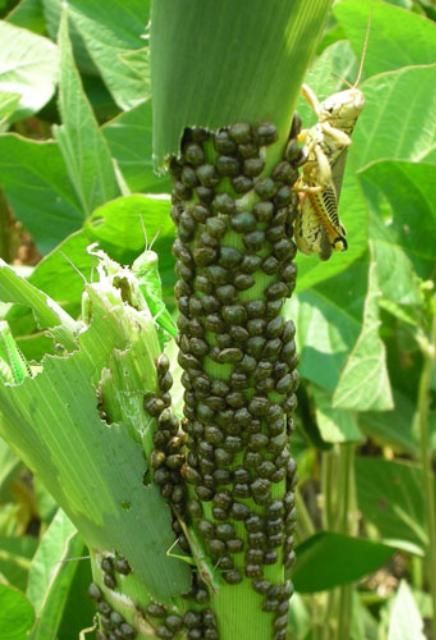
Credit: Jeremy Greene, Clemson University, http://www.bugwood.org
Click here to view an infestation of bean plataspid in Georgia.
Survey and Management
Horn and Hanula (2011) are developing monitoring traps using light colors to attract adult specimens. These monitoring traps may be a good tool to survey for bean plataspid. Sweep netting and hand-picking, although time consuming, are also good methods for surveying. For more information about surveying in your area, contact your local UF/IFAS Extension agent.
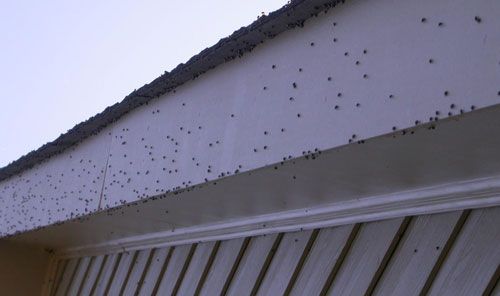
Credit: Daniel R. Suiter, University of Georgia, http://www.bugwood.org
Pyrethroids may be effective for temporary control. Contact your local UF/IFAS Extension agent for proper pest treatment methods.
As this insect moves from overwintering sites in search of food, the bean plataspid may become a nuisance pest in and around structures. Homeowners should ensure screening is placed over possible entries points of insects and that windows and doors are tightly sealed.
Acknowledgements
The authors extend their appreciation to Wayne A. Gardner of the University of Georgia for his review of this publication.
Selected References
Akin S, All J, Allen C, Boerma R, Buntin D, Cardinal A, Catchot A, Chen P, Clough S, Cook D, Davis J, Dively G, Greene J, Herbert A, Herbert J, Heitholt J, Jones W, Leonard R, Lorenz G, Miranda L, Musser F, Reed T, Reisig D, Roberts P, Smith R, Stewart S, Way M. (May 2011). A strategy for prioritizing research goals and outreach plans to reduce soybean production losses caused by stink bugs and related insect pests. SoyBase and the Soybean Breeder's Toolbox. (13 February 2023)
Eger Jr JE, Ames LM, Suiter DR, Jenkins TM, Rider DA, Halbert SE. 2010. Occurrence of the Old World bug Megacopta cribraria (Fabricius) (Heteroptera: Plataspidae) in Georgia: A serious home invader and potential legume pest. Insecta Mundi 0121: 1–11.
FDACS. (August 2011). Field Crops. pp. 30–41, In 2011 - Florida agriculture by the numbers. Florida Department of Agriculture and Consumer Services. (13 September 2016)
Halbert S, Eger Jr JE. (March 2010). Bean plataspid, Megacopta cribraria (Fabricius) (Hemiptera: Plataspidae) an exotic legume pest established in Georgia. FDACS-Division of Plant Industry. (13 September 2016)
Horn S, Hanula JL. 2011. Influence of trap color on collection of the recently-introduced bean plataspid, Megacopta cribraria (Hemiptera: Plataspidae). Journal of Entomological Science 46: 85-87.
Jenkins TM, Eaton TD. 2011. Population genetic baseline of the first plataspid stink bug symbiosis (Hemiptera: Heteroptera: Plataspidae) reported in North America. Insects 2: 264-272.
Jenkins TM, Eaton TD, Suiter DR, Eger Jr JE, Ames LM, Buntin GD. 2010. Preliminary genetic analysis of a recently-discovered invasive true bug (Hemiptera: Heteroptera: Plataspidae) and its bacterial endosymbiont in Georgia, USA. Journal of Entomological Science 45: 1-2.
Suiter DR, Eger Jr JE, Gardner WA, Kemerait RC, All JN, Roberts PM, Greene JK, L. Ames M, Buntin GD, Jenkins TM, Douce GK. 2010a. Discovery and distribution of Megacopta cribraria (Hemiptera: Heteroptera: Plataspidae) in northeast Georgia. Journal of Integrated Pest Management 1: 1-4.
Suiter DR, Ames LM, Eger Jr JE, Gardner WA. (September 2010b). Megacopta cribraria as a nuisance pest. Urban Entomology Pest Series. UGA-CAES Publications. (13 September 2016)